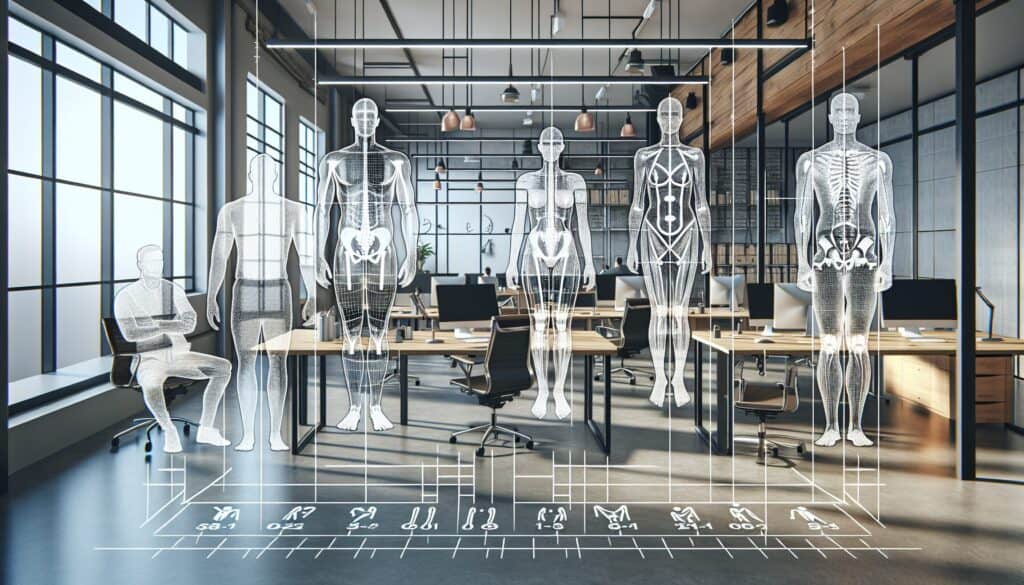Die Untersuchung der menschlichen Körpermaße und -proportionen als Grundlage für die Gestaltung von Arbeitsplätzen, Geräten und Produkten, die auf die Bedürfnisse der Benutzer zugeschnitten sind.
- Methodologien: Kunden & Marketing, Wirtschaft, Lean Sigma, Herstellung, Projektmanagement, Qualität
Anthropometrische Analyse

Anthropometrische Analyse
- Design für additive Fertigung (DfAM), Design für die Fertigung (DfM), Optimierung des Designs, Ergonomie, Menschliche Faktoren, Human-Centered Design, Benutzerfreundlichkeit, Benutzererfahrung (UX), Benutzerzentriertes Design
Zielsetzung:
Wie es verwendet wird:
- Die Verwendung anthropometrischer Daten (z. B. Größe, Reichweite, Länge der Gliedmaßen) der Zielgruppe, um sicherzustellen, dass die Abmessungen des Designs mit den körperlichen Merkmalen der Zielgruppe kompatibel sind.
Vorteile
- Hilft bei der Gestaltung von Produkten und Umgebungen, die für die Zielgruppe bequem, sicher und effizient zu nutzen sind; reduziert körperliche Belastung und Fehler; kann die Zufriedenheit der Nutzer verbessern.
Nachteile
- Die anthropometrischen Daten variieren je nach Bevölkerungsgruppe (Alter, Geschlecht, ethnische Zugehörigkeit) und müssen aktuell sein; die Gestaltung für eine große Bandbreite von Nutzern (z. B. 5. bis 95. Perzentil) kann eine Herausforderung darstellen; statische Messungen erfassen dynamische Aufgabenanforderungen möglicherweise nicht vollständig.
Kategorien:
- Ergonomie, Produktdesign
Am besten geeignet für:
- Nutzung der menschlichen Körpermaße für die Gestaltung von Arbeitsplätzen, Werkzeugen und Produkten, die für die vorgesehenen Benutzer geeignet sind.
Anthropometric Analysis applies extensively across various industries, including ergonomics, Industriedesign, and healthcare, facilitating the creation of tools, equipment, and workspaces that are inherently user-centric. This methodology is often employed during the early stages of product development, typically in user research and concept design phases, where understanding the physical characteristics of the target user population is pivotal. Participants in this process include product designers, engineers, ergonomists, and market researchers, who collaborate to gather and analyze anthropometric data relevant to their specific demographic. Industries such as automotive and aerospace rely heavily on this analysis, ensuring that vehicle interiors and control interfaces accommodate diverse user heights and body shapes, thereby enhancing safety and comfort. Similarly, in healthcare, ergonomic design of medical instruments and patient handling equipment is informed by anthropometric data, directly impacting healthcare outcomes through improved usability. The application extends to consumer products like furniture, where knowledge of human dimensions informs the ergonomic design of chairs and tables, ensuring that they can be used comfortably across a broad range of body sizes. This attention to anthropometric details not only reduces physical strain but also minimizes the risk of injury and errors during use, thereby enhancing operational efficiency and user satisfaction in multiple contexts.
Die wichtigsten Schritte dieser Methodik
- Identify the target user population and their representative anthropometric data.
- Select relevant dimensions based on specific tasks or interactions required by the design.
- Analyze the distribution of the selected data to determine the design limits (minimum and maximum values).
- Create design envelopes that accommodate the diverse range of body sizes and shapes within the user population.
- Iterate design concepts based on ergonomics principles and user interface interactions.
- Prototype and evaluate designs with a sample of the target population for usability testing.
- Refine designs based on feedback and performance observations to enhance fit and comfort.
Profi-Tipps
- Incorporate segmental data to refine ergonomic assessments, focusing on the distribution of body proportions among different demographics.
- Utilize dynamic anthropometry by assessing movement patterns and workspace interactions to create adaptable designs that accommodate varying user scenarios.
- Implement iterative prototyping based on anthropometric data to validate design dimensions through user testing, ensuring comfort and functionality align with real-world applications.
Verschiedene Methoden lesen und vergleichen, Wir empfehlen die
> Umfassendes Methoden-Repository <
zusammen mit den über 400 anderen Methoden.
Ihre Kommentare zu dieser Methodik oder zusätzliche Informationen sind willkommen auf der Kommentarbereich unten ↓ , sowie alle ingenieursbezogenen Ideen oder Links.
Historischer Kontext
1986
(wenn das Datum nicht bekannt oder nicht relevant ist, z. B. "Strömungsmechanik", wird eine gerundete Schätzung des bemerkenswerten Erscheinens angegeben)

Verwandte Artikel
Fragebögen zu muskuloskelettalen Beschwerden
Multivariate Tests (MVT)
Mehrfache Regressionsanalyse
Motion-Capture-Systeme
MoSCoW-Methode
Moods Median-Test